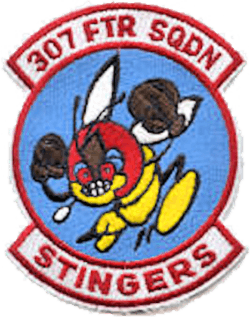307th Fighter Squadron
| 307th Fighter Squadron | |
|---|---|
|
307th Fighter Squadron Patch | |
| Active |
30 January 1942 – 7 November 1945 20 August 1946 – 1 July 1989 30 September 1991 – 31 August 1995 1 August 2003 – present |
| Country | United States |
| Branch | United States Air Force |
| Type | Fighter |
| Part of |
Air Force Reserve Command Tenth Air Force |
| Garrison/HQ | Seymour Johnson Air Force Base |
| Decorations |
|
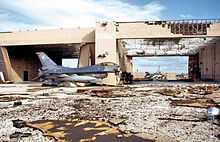
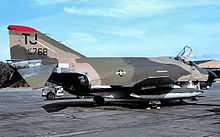
The 307th Fighter Squadron (307 FS) is an F-15E Strike Eagle unit and is part of the Air Force Reserve Command's 414th Fighter Group (414 FG) stationed at Seymour Johnson Air Force Base, North Carolina.
Mission
The mission of the 307 FS is to assist the 4th Fighter Wing at Seymour Johnson to produce qualified F-15E aircrew. The squadron became operational in September 2011.
History
World War II
Initially established under Third Air Force in early 1942 as a fighter squadron at Baer Field, Indiana, flying some antisubmarine patrols in the Gulf of Mexico.
Deployed to the European Theater of Operations (ETO) in June 1942 without aircraft as its P-40s and P-39s were deemed unsuitable for use against German aircraft in long range bomber escort duties. Was re-equipped with RAF Spitfire Vs and its pilots and technicians spent a two-month period undergoing intensive training in flying and fighting with RAF pilots in the British aircraft from airfields in southeast England. The squadron flew its first combat mission on 18 August 1942, when it attacked enemy positions in occupied France.
Assigned to the new Twelfth Air Force and deployed to Gibraltar in November 1942 as part of the Operation Torch invasion forces, initially operating from former Vichy French airfields in Algeria. Advanced east across Algeria and Tunisia during the North African Campaign, supporting the Fifth United States Army which halted Field Marshal Rommel's advance on allied positions.
Spitfires from the squadron provided support for Allied Forces as the Invasion of Italy began with the capture of Sicily, and later the landings by Allied forces in Fascist Italy, moving north supporting the Fifth Army during the Italian Campaign. As Allied bomber forces operating from Italy began the strategic bombing of Axis petroleum and communications facilities in central Europe and the Balkans, the squadron was re-equipped with the North American P-51 Mustang to replace the shorter-ranged Spitfire. In August 1944, the P-51's were involved in the invasion of Southern France. In December 1944, the first destruction of a German jet fighter by a 308th P-51 occurred, eventually operating from the Po Valley in Northern Italy at the end of the European War in May 1945.
By war's end, the squadron had earned two Distinguished Unit Citations and was involved in eight campaigns The squadron was largely demobilized during the summer of 1945 in Europe, a skeleton force returned to Drew Field, Florida in August, inactivating largely as an administrative unit in November.[1]
Reactivated from elements of several inactivating organizations in Germany in August 1946, Performed occupation duty and operating early-model P-80A Shooting Star jets from former Luftwaffe jet-capable airfields at Giebelstadt and Kitzingen. Returned to the United States in June 1947 without personnel or equipment which remained in Germany.
Cold War
Assigned to Strategic Air Command at Langley AFB, Virginia as a fighter-escort squadron, equipped with straight-winged F-84E Thunderjets. Assigned to Turner AFB, Georgia with mission of long-range escort of B-29 Superfortress bombers, later B-50 and B-36 Peacemakers as newer aircraft came into operation by SAC. Inactivated 1958 with phaseout of B-36 and end of SAC escort fighter concept.
Reactivated in 1959 as Tactical Air Command F-100 Super Sabre fighter-bomber squadron at George AFB, California. Trained in tactical air support of ground forces, deploying to NATO bases for operational exercises. Reassigned to Homestead AFB, Florida after the Cuban Missile Crisis, late 1962 to provide air defense of South Florida. Was deployed to Southeast Asia, 1964 as part of advisory forces operating against North Vietnamese and National Liberation Front forces in South Vietnam.
Reassigned to NATO, becoming permanently based at Torrejon AB, Spain in 1966 when SAC turned Spanish bases over to USAFE. Initially equipped with F-100s, in 1970 received F-4E Phantom IIs. Reassigned back to TAC at Homestead AFB in 1971, as part of re-establishment of 31st TFW upon its return from duty in Southeast Asia. Was deployed to Thailand, July 1972, engaging North Vietnamese forces in northern South Vietnam in response to the communist spring offensive. Returned to the United States in the late fall, 1972.
For the next 20 years, performed routine training and tactical deployments from Homestead AFB, upgraded to the F-16A Fighting Falcon in 1988. At the end of 1986 the squadron and wing changed tail codes from ZF to HS which better matched the squadrons location in Homestead. Upgraded to the F-16A Fighting Falcon in 1988, upgrading to receive Shaw AFB block 25s in August 1990. With the Gulf War build up and the 363rd TFW at Shaw AFB deploying to Saudi Arabia meant no more block 25s were available. With some F-16A/B block 15s still in service for the 307th TFS, it continued to operate both types.
When Desert Storm ended it was decided to convert the 31st TFW to block 40 F-16s instead. Up to this point about ten block 25s had reached the 307th FS and had been pained in 'Emerald Knight' markings. They were all sent to other units. Neither of the 31st TFWs other sister squadrons flew the block 25. In March 1991 the 307th began conversion to the block 40 version of the F-16. On 1 October 1991 the word 'Tactical' was dropped and unit became the 307th Fighter Squadron. By early 1992 the conversion to block 40 F-16s with the general purpose role was complete.
Moved to Moody AFB, Georgia in late August 1992 when Hurricane Andrew threatened South Florida. It was to be a temporary move to Moody, but Homestead AFB was so heavily damaged it was never re-opened for any of the 31st FW squadrons and was eventually turned over to the Air Force Reserve Command's 482nd Fighter Wing and renamed Homestead ARB. After the destruction of Homestead AFB, the 307th FS was reassigned permanently to the 347th Operations Group at Moody. At this point the 'HS' tail code began to be replaced with a 'MY' tail code, with some block 40 F-16s were delivered right from the factory to the 307th Fighter Squadron's new home base. It deployed to Saudi Arabia from, March–June 1995 in support of Operation Southern Watch.[2] Inactivated in 1995 when Air Combat Command temporarily closed down ACC operations at the base, temporarily turning Moody AFB over to Air Education and Training Command as a training base.
Modern era
Reactivated in 2003 as an Air Force Reserve Command F-15 Eagle training squadron. Trained Air Force Reserve pilots in F-15 Eagles at Langley AFB, Virginia as an adjunct for the 1st Fighter Wing. The unit was moved from Langley AFB to Seymour Johnson AFB in 2010 in realignment with the phaseout of the F-15C at Langely pending the arrival of the F-22 Raptor and the need for an "Associate" Air Force Reserve F-15E Strike Eagle unit at Seymour Johnson.
Lineage
- Constituted 307th Pursuit Squadron (Interceptor) on 21 Jan 1942
- Activated on 30 Jan 1942
- Re-designated 307th Fighter Squadron on 15 May 1942
- Re-designated 307th Fighter Squadron, Single Engine on 20 Aug 1943
- Inactivated on 7 Nov 1945
- Activated on 20 Aug 1946
- Re-designated 307th Fighter Squadron, Jet Propelled on 19 Feb 1947
- Re-designated 307th Fighter Squadron, Single Engine on 3 Nov 1947
- Re-designated 307th Fighter Squadron, Jet on 15 Jun 1948
- Re-designated 307th Fighter-Bomber Squadron on 20 Jan 1950
- Re-designated 307th Fighter-Escort Squadron on 16 Jul 1950
- Re-designated 307th Strategic Fighter Squadron on 20 Jan 1953
- Re-designated 307th Fighter-Bomber Squadron on 1 Apr 1957
- Re-designated 307th Tactical Fighter Squadron on 1 Jul 1958
- Re-designated 307th Tactical Fighter Training Squadron on 1 Jul 1983
- Re-designated 307th Tactical Fighter Squadron on 1 Apr 1988
- Inactivated on 1 Jul 1989
- Activated on 30 Sep 1991
- Re-designated 307th Fighter Squadron on 1 Nov 1991
- Inactivated on 31 Aug 1995
- Activated in the Air Force Reserve Command on 1 Aug 2003
Assignments
- 31st Pursuit (later, 31st Fighter) Group, 30 Jan 1942 – 7 Nov 1945
- 31st Fighter (later, 31st Fighter-Bomber; 31st Fighter Escort) Group, 20 Aug 1946
- Attached to 31st Fighter-Escort Wing, 27 Jul 1951 – 15 Jun 1952
- 31st Fighter-Escort (later, 31st Strategic Fighter; 31st Fighter-Bomber; 31st Tactical Fighter) Wing, 16 Jun 1952
- Attached to: Alaskan Air Command, 7 Nov – 7 Dec 1956
- Attached to: 48th Fighter-Bomber Wing, 27 Feb – 9 Aug 1958
- Attached to: Unknown, 15 Mar – 19 Jul 1959; 8 Nov 1960 – 9 Mar 1961, and 18-28 Feb 1962
- Attached to: 18th Tactical Fighter Wing, 17 Dec 1962 – 16 Mar 1963
- Attached to: Unknown, 27 Dec 1963 – 5 Mar 1964
- Attached to: 7231st Combat Support Group, 23 Nov 1964 – 14 Mar 1965
- Attached to: 34th Tactical Group, 24 Jun – 7 Jul 1965
- Attached to: 6251st Tactical Fighter Wing, 8 Jul – 20 Nov 1965
- Attached to: 3d Tactical Fighter Wing, 21 Nov – 6 Dec 1965 (a/c and personnel transferred to 531st Tactical Fighter Squadron)
- 401st Tactical Fighter Wing, 27 Apr 1966
- 31st Tactical Fighter (later, 31 Tactical Training; 31 Tactical Fighter) Wing, 15 Jul 1971 – 1 Jul 1989
- Attached to: 432d Tactical Reconnaissance Wing, 29 Jul – 31 Oct 1972
- 31st Tactical Fighter (later, 31st Fighter) Wing, 30 Sep 1991
- 31st Operations Group, 1 Nov 1991
- Attached to: 347th Operations Group, c. 11 Sep – 19 Nov 1992
- 347th Operations Group, 20 Nov 1992 – 31 Aug 1995
- Tenth Air Force (AFRC Associate unit to 1st Fighter Wing), 1 Aug 2003
- 414th Fighter Group, 23 March 2010 – present
Stations
|
|
Aircraft
|
|
Operations
Emblems
-
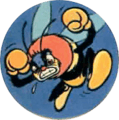
World War II unit emblem
-
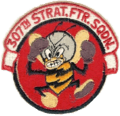
SAC Strategic Fighter emblem
-
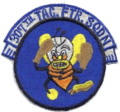
TAC Emblem, 1960
References
![]() This article incorporates public domain material from websites or documents of the Air Force Historical Research Agency.
This article incorporates public domain material from websites or documents of the Air Force Historical Research Agency.
See also
| ||||||||||||||||||||||||||||||||||
| |||||||||||||||||||||||||||||||||||||||||||||||
